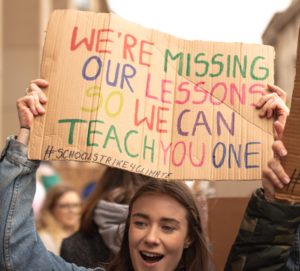How teachers can help these highly diverse students make sense of the modern world

Every generation brings a fresh perspective on social and political issues, and educators have to find ways to adjust to these changes. The post-millennial generation of young Americans currently coming of age, known as Generation Z, has already cemented its reputation as politically engaged, highly educated and very diverse. While there are actually fewer foreign-born post-millennials than millennials, they are still highly likely to come from immigrant families. Nearly one-third of “Gen Z” is either an immigrant or the child of immigrants, and almost half is non-white.
While research shows that diversity is beneficial, it can be challenging for students to reap those benefits when anti-immigrant rhetoric and racial tensions dominate the national stage. Professor John Rogers at UCLA notes that 89 percent of high school principals report “incivility and contentiousness in the broader political environment has considerably affected their school community,” and an additional 83 percent see untrustworthy and disputed information fueling inner-school tensions.
Fortunately, there are techniques educators can use to help ensure that young people are getting the culturally competent support they need, even in environments where race and immigration are contentious topics. Some tips are provided in this article. We’ll be diving further into these techniques in our next free webinar Understanding Immigration Today: Current Events in the Classroom on February 12, 2020.
Media Literacy
 In order to develop these dispositions, students need to feel safe to engage and express themselves. Classrooms can be a place to learn accurate information about current events and hold compassionate, evidence-based discussions.
In order to develop these dispositions, students need to feel safe to engage and express themselves. Classrooms can be a place to learn accurate information about current events and hold compassionate, evidence-based discussions.
Gen Zers get their news predominantly from the internet and social media. This means that not only are they vulnerable to seeing false or incomplete information, they are also exposed to confusing opinions and hurtful biases. They need to learn how to tell opinion from fact and fact from fiction. Teachers can help their students by incorporating current events into the classroom and showing students how to evaluate “news.”
There are a number of resources for children and teenagers that explain the headlines in age-appropriate formats, ranging from NBC Learn for ages seven and older to PBS NewsHour Extra for 14 and above. It can also be useful for students to share opinions in the classroom, especially if there are clear guidelines around using respectful language. By exploring these resources and discussions in a classroom, students can form their own opinions with accurate information in a compassionate and calm environment.
Attitude Adjustment

One of our content partners, Re-imagining Migration, creates curricula and related resources for diverse classrooms. They’ve identified five key dispositions that are essential for success in a diverse environment:
- Understand Perspective: value one’s own and others
- Inquire: be curious and the inclination to ask relevant and informed questions
- Communicate: build relationships across differences
- Recognize Inequality: historical and current
- Take Action: everyone can help make the classroom more inclusive
Educators who teach the skill set and attitudes that correspond to these dispositions can help their students face an uncertain world. Even the most dedicated teacher can’t prepare students for every painful situation or ethical dilemma, but they can help students develop critical thinking and emotional resilience.
Let Them Lead
 It’s not only young people who have something to learn. Educators have great reasons to put faith in their students and give them opportunities to lead. Sometimes called iGen, this generation has grown up in the digital age with a wealth of information at their fingertips, and they are showing themselves to be both well-informed and highly motivated by education and new experiences. They also tend to value diversity and have a more international outlook than previous generations. As this cohort of young people enters universities and workplaces, they are sure to infuse these values into their institutional cultures and society at large. So while teachers can and should take steps to help their students grow, there are times when students can lead the way.
It’s not only young people who have something to learn. Educators have great reasons to put faith in their students and give them opportunities to lead. Sometimes called iGen, this generation has grown up in the digital age with a wealth of information at their fingertips, and they are showing themselves to be both well-informed and highly motivated by education and new experiences. They also tend to value diversity and have a more international outlook than previous generations. As this cohort of young people enters universities and workplaces, they are sure to infuse these values into their institutional cultures and society at large. So while teachers can and should take steps to help their students grow, there are times when students can lead the way.
More Resources
- If you find this topic valuable, sign up for our next free webinar.
- Take advantage of the on-demand resources from our previous Educator Webinars and partners.
- Re-imagining Migration has an incredible stock of resources for educators teaching about immigration.
- Colorín Colorado offers strategies, best practices, books, videos and more to educators and families of English language learners (ELLs).
